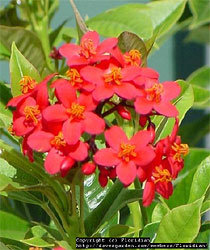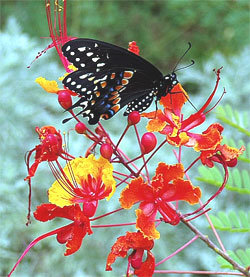





Earning Texas SuperStar? status certainly isn?t easy. A plant must not only survive, but thrive, in blistering heat, drought, clay soil and sometimes violent weather.
Texas A&M's Agricultural Program makes it simple for Texas gardeners by doing the testing for us. The university is continually putting plants through the paces to see if they can take our harsh conditions. The plants are of all types: perennials, annuals, water lilies...there's even an orchid on the list.
Outdoor plants are field tested for several years, and they aren't pampered by any means. In fact, most are given minimal water, little soil preparation and no pesticides. They must also be deemed "useful yet unique," - that is, they cannot be considered a specialty plant or an overly common one, and they must be easy for growers to propagate.
If, after all the abuse has ended, the trial plant makes it, they get the highly-acclaimed designation of Texas SuperStarTM. To date, there are around 40 plants that have earned this title, and we're about to see a few more in 2008. Drumroll please!
 May welcomes the Texas SuperStarTM debut of Jatropha Compacta (pictured at left), a tropical-esque evergreen shrub or small tree with glossy leaves and clusters of star shaped bright scarlet or vermilion flowers. The plant has a rounded or narrow domed form. The flowers are about 1 inch across and borne in multi-flowered terminal clusters almost all year round when growing in full sun to partial shade.
May welcomes the Texas SuperStarTM debut of Jatropha Compacta (pictured at left), a tropical-esque evergreen shrub or small tree with glossy leaves and clusters of star shaped bright scarlet or vermilion flowers. The plant has a rounded or narrow domed form. The flowers are about 1 inch across and borne in multi-flowered terminal clusters almost all year round when growing in full sun to partial shade.
Jatropha is a spectacular shrub in bloom, which is most of the year. Use it as an accent or in a mixed shrub border. Jatropha is not salt tolerant, but does well in a wide variety of soils so long as they are well-draining. This plant also makes a fine container specimen on the patio or at pool side and attracts butterflies and hummingbirds. Give it full to part sun outdoors, indoors away from direct sun. Fast growing to 4 to 6 feet tall and 3 to 5 feet wide, tree-like with age. Jatropha is hardy down to 30º.
Lastly, know that Jatropha is a member of the Euphorbia family, so watch your skin when touching - some folks experience skin irritation when handling euphorbias, especially the milky sap inside the plant.
 In July, the newest Texas SuperStarTM to hit the red carpet will be Pride-Of-Barbados (Caesalpinia pulcherrima) (pictured at right). Like Jatropha, Pride-Of-Barbados is an evergreen shrub or small tree in frost-free climates, a deciduous shrub in zone 9, a returning perennial in zone 8b, and an annual in zones 8a and northward. In some tests, they have survived temperatures as low as 18 F.
In July, the newest Texas SuperStarTM to hit the red carpet will be Pride-Of-Barbados (Caesalpinia pulcherrima) (pictured at right). Like Jatropha, Pride-Of-Barbados is an evergreen shrub or small tree in frost-free climates, a deciduous shrub in zone 9, a returning perennial in zone 8b, and an annual in zones 8a and northward. In some tests, they have survived temperatures as low as 18 F.
The plant is prolific, even in non-tropical zones, usually getting 8-12 feet tall even after freezing to the ground the previous winter.
The leaves are delicate and fernlike, while the flowers are spectacularly showy blossoms of orange and red. The flowers are bowl shaped, 2-3 inches across, with five crinkled, unequal red and orange petals, and ten prominent bright red stamens. It flowers in mid to late summer (depending on size of transplant used) and fall.
Pride-Of-Barbados is very easy to grow in alkaline to acidic, well-drained soils. It is a fast growing plant especially when the temperatures are hot and in full sun to partial shade, blooming best when given full sun. It is moderately tolerant of salty conditions and is extremely drought tolerant.
These plants aren't just for Texans, of course. If you live in one of the zones where these plants thrive, give them a try. Or pot them up and enjoy them as an indoor accent.
More information about Texas SuperStarsTM can be found at the official website, http://www.texasSuperStar.com/.
Copyright © www.100flowers.win Botanic Garden All Rights Reserved